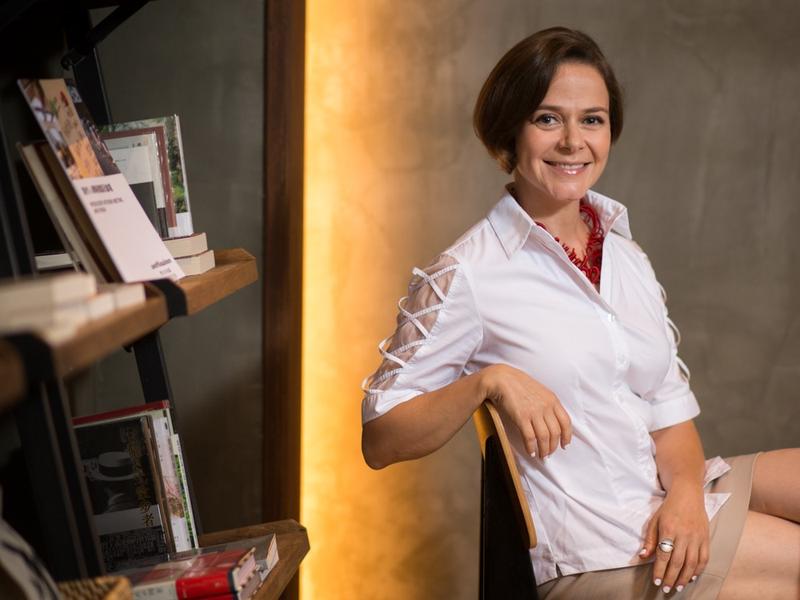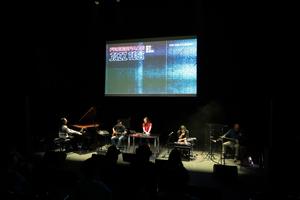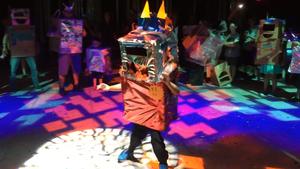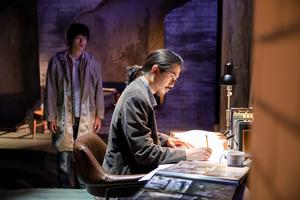Editor’s Note: Alison M. Friedman, the artistic director of Performing Arts, West Kowloon Cultural District Authority, is looking forward to presenting a rich haul of locally-developed projects that have been in the making during the months of the pandemic. In an exclusive interview to China Daily, Friedman reveals how she and her team have been making the most of the challenges posed by COVID-19 to innovate, and more. Excerpts:
 Nurturing the growth of new cultural forms is the focus of her organization in the current year, says Alison M. Friedman, artistic director of Performing Arts, West Kowloon Cultural District Authority. (PHOTO PROVIDED TO CHINA DAILY)
Nurturing the growth of new cultural forms is the focus of her organization in the current year, says Alison M. Friedman, artistic director of Performing Arts, West Kowloon Cultural District Authority. (PHOTO PROVIDED TO CHINA DAILY)
There seems to be a distinct change of vibe between the video series of An Invitation: On Empty Theatre posted in mid-2020 and the Dear 2021 series that went up in December 2020 on the West Kowloon video platform, although Hong Kong’s cultural scene looks pretty much the same since the pandemic began – the venues are still closed and there are no gigs in sight. And yet, the mood in those videos seems to have changed from introspective and anxious to a more determined and hopeful one. Can we take this as a reflection of the general mood of West Kowloon performing arts team and its collaborators?
Absolutely, the two (sets of videos) were done at very different times of the pandemic, over half a year apart, and it reflects where West Kowloon and all of our partner artistes have journeyed. I would say the shift is from shock to acceptance, from reaction to responding. With determination, hope and creativity, we are trying to live with the new uncertainty and get beyond it.
Is there a reason that inspired the change of mood?
The reason for doing the Dear 2021 series was to show that despite the pandemic West Kowloon continues to partner with artistes, make new work and bring it to the community, support artistes on their own journeys, (foster) the spirit that we’re all in it together and we’re going to make it, together.
What would you say is West Kowloon’s most bankable asset that makes you hopeful about the future of performing arts at a crises-ridden time like this?
People! While the perception is that West Kowloon’s most bankable assets are its buildings, they remain closed during the pandemic, but our people continue to collaborate and inspire, make art and bring it to the community.
What’s unique about West Kowloon, compared to other cultural organizations in Hong Kong is that we are staffed by creative producers. Our heads of theater, dance, music, xiqu and learning teams are all creative workers themselves – arts workers involved on the producing side. They are connected throughout the artistic communities in Hong Kong and the world.
 Hong Kong musician Angelita Li performs at the West Kowloon-hosted Jazz Fest in November 2020. (PHOTO PROVIDED TO CHINA DAILY)
Hong Kong musician Angelita Li performs at the West Kowloon-hosted Jazz Fest in November 2020. (PHOTO PROVIDED TO CHINA DAILY)
We saw a lot of live show recordings uploaded online by the likes of The National Theatre and Royal Ballet from the UK and Montreal’s Cirque de Soleil since the pandemic began. Do you see West Kowloon-produced live shows being adapted into online formats in the future?
We are having ongoing conversations between our team and artistes on the kind of content we want to produce. A lot of the companies putting things online have been around for decades and so have vast archives, while we’re a new organization, in the process of creating fresh work.
The other conversation we’re having is: what can we create digitally that will still be relevant after COVID-19? We want to produce content that is intended for the (online) format. We’re looking to have the technology tools support creative ideas and not the other way round.
We’re also exploring ways in which we create new works intended for the hybrid on-site-online world that we’re going to live in, moving forward. We don’t want people to feel they’re watching an online show that is better suited to a live on-site experience. For this coming season we’re commissioning new works by independent dancers and theater artistes who are specifically tasked with integrating online and on-site experiences.
Online adaptations of live shows will entail putting people having specialized skill sets on the job. What’s the progress on that front?
What’s exciting about the process of reaching out to people with specialized skills is the many ways we can collaborate with them. For example, we just hosted a panel discussion with the members of On & On Theatre Workshop, to talk about the play Waking Dreams in 1984. It was originally intended as a live performance but (eventually) livestreamed in January 2021. Over a thousand people bought tickets to watch the online shows, and we got great feedback. It involved professional film directors, videographers and editors who knew how to get the best shots, knew the play well enough to be able to edit live. The actors employed acting techniques that adapt better to performing for camera versus live audiences. Also, our technology team made sure we had exceptionally strong Wi-Fi to be able to transmit the show (in real time).
In one of our forthcoming performances this season, the audiences will remote control the robot performers from their own homes using their computers. It’s like a video game with artistic content. It doesn’t require specialized equipment, is very accessible and allows audiences to be more actively engaged.
At the other extreme is trying to create at-home experiences with an offline element. For instance, in December 2020 we hosted a show called Robot House Party. Kids made robot costumes using cardboard boxes, markers, tape and whatever materials they had at home. Kid Koloa, a world-famous DJ from Montreal, joined dance artistes in North America and Hong Kong to lead a dance party for kids after they put the costumes on. So there was a digital interaction with physical dance parties. Moving forward, our goal is to explore ways of integrating offline experiences into online shows.
 In With/Out Umeda Japanese dancer Hiroaki Umeda combined live dancing with simultaneous VR video streaming. (PHOTO PROVIDED TO CHINA DAILY)
In With/Out Umeda Japanese dancer Hiroaki Umeda combined live dancing with simultaneous VR video streaming. (PHOTO PROVIDED TO CHINA DAILY)
In terms of programing, will West Kowloon’s focus remain largely on local artists and locally-developed productions until international travel restrictions are lifted? This might in fact be an opportunity to focus on developing homegrown content…
Exactly, the silver lining of COVID-19 is the opportunity to explore and showcase the unbelievable talent in Hong Kong. And the perfect example of this is the Jazz Fest we held in November 2020.
Initially, people were skeptical. They said, how are you going to have a jazz festival without an international headliner? In fact, we had more sold-out shows this year than the previous year that featured international headliners. We worked with local legends like Angelita Li, Eugene Pao and Ted Lo on new projects that pushed them out of their comfort zones. Jazz Fest was the perfect example of showcasing (a line-up) that was one hundred percent local artistes, (presented) in ways that the audiences got to see them anew.
In 2021, most of our on-site programs are collaborations featuring local artistes.
The pandemic could be seen as an opportunity to try out new cultural forms. For instance, in the West Kowloon-produced dance and movement series, Cypher, we saw the dancer Hiroaki Umeda explore the interface of his own live dancing and its simultaneous VR video streaming. Are we going to see more of these?
You will definitely see Umeda again. We are developing his project with gaming artistes and Umeda’s online avatar even further.
In terms of new cultural forms, that’s absolutely the focus of West Kowloon’s programming this year. We are looking to support innovations in which form and function are aligned. Besides developing remote controlled robot experience that I mentioned, we are also thinking of offline, non-digital collaborations. One of the ideas we are exploring is that, instead of buying a ticket, you buy a creative care package, mailed to your home. You would make something by following instructions and share it online. Then people who bought the tickets could all come online and put the project together. It’s a way of making an offline project more experiential instead of just sitting back and watching a screen.
Would you like to give us a sense of what that care package might contain?
One of the hazards of COVID-19 is that you feel disconnected from other people and also from your body, because you are stuck at home. So we are exploring ways that can help people connect with others as well as reconnect with their bodies by getting up and moving. So if you receive a care package containing a DIY kit, you could put it together yourself or with help from the online community and share images online.
 In mid-2020, West Kowloon produced a video series in which 30 performance artistes from Hong Kong mused on the impact of pandemic-triggered closure of venues on their lives. (PHOTO PROVIDED TO CHINA DAILY)
In mid-2020, West Kowloon produced a video series in which 30 performance artistes from Hong Kong mused on the impact of pandemic-triggered closure of venues on their lives. (PHOTO PROVIDED TO CHINA DAILY)
One way of getting round the current restrictions on people gathering in cultural venues could be by thinking in terms of alternative performance spaces as opposed to a closed theater. What are your thoughts regarding transferring some of the shows to West Kowloon’s sprawling parks?
One of West Kowloon’s most spectacular assets is our Art Park. It’s right there on Victoria Harbour, and throughout the pandemic people have been coming, regardless.
In November 2020, we hosted a socially-distanced dance performance Maybe Tomorrow@Freespace, with big, reflective installation orbs, directed by Chloe Wong. We set up multicolored ropes on the ground that helped ensure social distancing and were also kind of fun for the audience. The Art Park tends to get a bit crowded, so we had to innovate in order to ensure safety of the audience.
We have a huge exterior wall of Freespace which is designed for outdoor projection and where we have done film screenings in the past. So having a performance in the theater while the audience is out on the lawns, watching the content projected on the wall, is also an option we are exploring.
How do you see the future of highly participatory and interactive theater in the time of social distancing? For instance, Tea House Theatre (a facility to introduce Cantonese opera to new audiences) has a dining element which had to be sacrificed owing to safety precautions. Also West Kowloon had planned a show with Rimini Protokoll that would have involved a hundred Hong Kong people participating in every show. How could such challenges be addressed?
Our producers and artistes are problem-solvers at their core. For example, in our Tea House Theatre, food and beverage served during the show was replaced by takeaways when socially-distanced performances with live audience were allowed last year.
I hope we can still stage the Rimini Protokoll work 100% Hong Kong toward the end of 2021. Maybe we can do it in a socially-distanced mode, in a venue that’s different (from a closed theater). One thing that COVID-19 has taught us is to not assume that the way we had planned on doing something is the only way.
What’s the progress on the HK$3-million West Kowloon’s Arts Relief Scheme, raised with contributions by the board chair Henry Tang, and the concern’s senior executive team, to help develop new work in order to support the artistes’ community in Hong Kong in the time of the pandemic?
We selected 13 projects from hundreds of applications. One of the projects, called The Show Will Go OnLine, by Music Lab Co. Ltd, was staged at Haw Par Music and streamed live. We recently saw the first drafts of another project, a mini musical drama, IN/SIGHT (by Lee Chak-man Leonard), about a visually-impaired Hong Kong singer Michelle.
 Musicians from Taiwan, Switzerland and Hong Kong came together for real-time virtual collaborations as part of West Kowloon’s Jazz Fest. (PHOTO PROVIDED TO CHINA DAILY)
Musicians from Taiwan, Switzerland and Hong Kong came together for real-time virtual collaborations as part of West Kowloon’s Jazz Fest. (PHOTO PROVIDED TO CHINA DAILY)
Will West Kowloon’s support extend to staging of these productions that are now in development?
The idea behind the Arts Relief Scheme was seed funding to launch the projects and support new creative explorations that respond and adapt to our current pandemic situation. It’s like planting seeds without knowing how many of them are going to grow. We’re eager to see which ones could be developed, both for live as well as digital stages.
Is there a takeaway from coping with more than one and a half years of cancellation and rescheduling of programs that you think might be useful in the post-pandemic scenario?
West Kowloon was one of the first cultural organizations in Hong Kong to go digital in response to venue closures because of COVID-19. Theaters shut in late January 2020 and our first live broadcast went out in early February 2020.
At that time live shows were still allowed in food and beverage establishments. So we did live broadcasts of the shows in Freespace’s Lau Bak Livehouse three times a week for six weeks and reached out to over a hundred thousand people. We found people all over the world were discovering Hong Kong artistes through our live streams.
Going online has allowed us to share performances across borders in a way that was not a focus before. For example, in our Jazz Fest, originally we were supposed to have musicians from abroad come to Hong Kong for workshops, collaborations and then a final showcase with a live audience. Instead, we were able to get very high-speed internet so there was no time lag between musicians from Taiwan and Switzerland, who were on a big screen, and those from Hong Kong who were in the room with the audience. We had live improv jam sessions that were so fabulous nobody felt the show would have been any different if all the musicians were in the room.
COVID-19 has made us better at focusing on the goal we need to achieve and then getting everybody to align toward the same mission. When the venue closures started happening and we were rescheduling, we had to consider if the goal was to preserve live shows, save budgets, reschedule or cancel, help the artistes survive or go online and so on. So we had to make quick decisions regarding each project, often with limited information about what may or may not be allowed in theaters, and then all align toward delivering that agreed direction.
One of the takeaways that will certainly continue is the digital collaborations and rehearsals. This works very well with musicians, and we have been piloting it with dancers as well. Of course nothing beats in-person collaboration and sharing the same physical space, but a period of online sharing elongates the creative process before artistes from different places meet in person. This will allow longer and more in-depth collaborations between international artistes in the future. We would never have considered this option if we weren’t forced to do it because of COVID-19.
Normally these international collaborations are expensive and resource heavy. (Often) visiting artistes have only one or two weeks in Hong Kong to create new work and it can be really stressful. By collaborating online, the pressure related to (limited) time and money is less. It allows international collaborations to develop more organically. In the future, when we can travel again, those in-person experiences will be built on a much more stable foundation.
 Children made their own costumes to join Robot House Party from home, while interacting with Montreal-based DJ Kid Koloa and dance artistes in North America and Hong Kong online. (PHOTO PROVIDED TO CHINA DAILY)
Children made their own costumes to join Robot House Party from home, while interacting with Montreal-based DJ Kid Koloa and dance artistes in North America and Hong Kong online. (PHOTO PROVIDED TO CHINA DAILY)
Would you have any thoughts on creating sustainable livelihoods for people who work both on and offstage when there are no gigs?
That is a huge systemic social problem and no single organization can fix it. The Chinese phrase is: “人人有責” which means “everybody has a responsibility.” The government certainly does.
West Kowloon has contributed through the Arts Relief Scheme, paid the artistes and technicians whenever possible, although all our contracts with the artistes have a force majeure clause. It wasn’t necessarily in West Kowloon’s best interests, but it was in the best interests of the arts sector and our partners.
We need to get just as creative with new business models as we are getting with new artistic models, maybe have more interfaces with the gaming industry, explore different kinds of sponsorship and pay-what-you-want models. It’s an opportunity to test new business models through trial and error.
Do you think hybrid forms combining online and on-site performances will continue in the foreseeable future? Are there any advantages of this arrangement that will work in a COVID-free world as well?
One of these is (enhanced) accessibility. People who do not live in a (particular) city can access events happening there online. Also people who do live in that particular city might have issues with mobility, hearing or eyesight. The opportunity in digital-live hybrids is that it allows one to explore the accessibility (potential) in new and different ways.
The other benefit has to do with learning. For example, the Xiqu Centre’s mission is to broaden audiences and deepen understanding of a traditional art form. We’re exploring possibilities including when you buy a ticket maybe you get a five-minute video explaining three things you want to know about the show to appreciate it better. So these are ways in which we enhance the live experience with the online content we develop.
One of the downsides of moving live shows online or going for hybrid formats is that a number of jobs will get cut. Any thoughts on the possibilities of monetizing online content while making sure that the benefits percolate down to the support staff in the arts sector?
Indeed, live shows involve a massive infrastructure of specialized work by ticket takers, janitors, ushers, make-up artistes, designers, dry cleaners, and so on. Some of them will be back after COVID-19 (restrictions ease) and some may transfer to new industries. As we develop new content and new formats for delivering that content, we’ll certainly see new job opportunities and new skills that hopefully will replace whatever might be lost.
For example, the marketing of online content will require a skill set that’s different from marketing on-site content.
 Over a thousand people bought tickets to watch the online show of On & On Theatre Workshop’s play Waking Dreams in 1984, presented by West Kowloon in January 2021. (PHOTO PROVIDED TO CHINA DAILY)
Over a thousand people bought tickets to watch the online show of On & On Theatre Workshop’s play Waking Dreams in 1984, presented by West Kowloon in January 2021. (PHOTO PROVIDED TO CHINA DAILY)
In the light of the Hong Kong government’s recent pledge to fund Art Tech projects, is West Kowloon considering commissioning more tech-based/tech-heavy shows?
We would love to create AR and VR experiences like we have done in the classical music realm — virtual orchestras where you put on VR goggles and suddenly you are sitting next to the first violinist on stage. So we’ll be looking to adapting some of these existing models for Chinese opera, to engage younger kids, especially.
On the creative side, we’re looking at how we can support artistes wanting to integrate new technologies into their creative practice. Our venues are already equipped with capacity to do interesting things with digital. We’re looking at professional development opportunities for our staff to become more technologically savvy.
The government push to develop Art Tech is doubtless an opportunity for artists and creative directors to critically examine the interface of art and technology, even make this a part of the aesthetic of the new works they produce. Any thoughts on how West Kowloon might support such efforts?
Creating timeless works of art that move emotions and are relevant to our lives is something that comes from the artistes and not from technology. Technology is the tool that helps artistes express what they have to say – it’s a means to an end. I think it’s a very valuable investment by the government into those means. (Its success) will depend on whether the concerned artiste has an urgent, burning thing to say through those tools.
Among West Kowloon’s forthcoming projects, Rooftop Productions is working on robotics. Littlebreath Creative Workshop is exploring the realm of dreaming and technology. A trio of digital, visual and dance artistes – Rita Hui, Wong Pik-kei and Wong Ka-ying – are looking at the role of the body in a digital world.
We would like to create experiences in which the human body's role in the enjoyment of traditional theater is restored in the viewer’s home.
Interviewed by Chitralekha Basu


